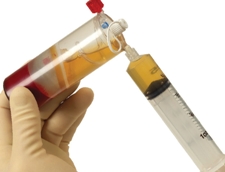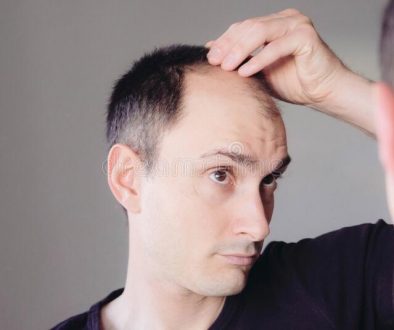Hair Transplant Surgeon Dr. Alan Feller Shares Platelet Rich Plasma (PRP) Hair Loss Treatment Update
Of all the new non-surgical hair loss treatments being researched, tested, and offered (in the preliminary phases) today, one frequently discussed by patients is Platelet Rich Plasma (PRP) injections.
 Platelet Rich Plasma is a process where a patient’s blood is drawn, separated and concentrated through a process called centrifugation, and re-injected into desired areas of the body. In theory, the PRP process concentrates useful cellular components of the blood and injects them into areas where the body can utilize the additional resources. The practice has been used for many years in wound healing and sport injury therapies, but now its focus is shifting toward treating hair loss.
Platelet Rich Plasma is a process where a patient’s blood is drawn, separated and concentrated through a process called centrifugation, and re-injected into desired areas of the body. In theory, the PRP process concentrates useful cellular components of the blood and injects them into areas where the body can utilize the additional resources. The practice has been used for many years in wound healing and sport injury therapies, but now its focus is shifting toward treating hair loss.
One of the proponents and practitioners of Platelet Rich Plasma injections for hair loss is Coalition hair transplant surgeon Dr. Alan Feller. For a number of years, Dr. Feller has offered PRP injections at his New York hair restoration practice and is pleased with the continual results.
Recently, Dr. Feller chose to share an interesting Platelet Rich Plasma case with our Hair Loss Social Community and Discussion Forums. In the case presentation, Dr. Feller displays the results of a 35 year old female patient who underwent PRP injections 9 months earlier. According to Dr. Feller:
My initial interest in PRP was based on the ability to offer a useful and practical treatment for patients who were not candiates for surgical hair restoration, ie: most woman and young men who are just beginning the miniaturization process … I’m a massive skeptic about everything in general, but some of these PRP results are quite impressive. This one is about as clear cut as you get and she is truly over the moon with it. She said her hair stylist noticed the obvious improvement without knowing she received PRP treatment; and that kind of confirmation is priceless.
To review these results and discuss Platelet Rich Plasma hair loss injections, please visit the discussion topic PRP Results – Dr. Feller
_______________
Blake – aka Future_HT_Doc
Editorial Assistant and Forum Co-Moderator for the Hair Transplant Network, the Hair Loss Learning Center, the Hair Loss Q&A Blog, and the Hair Restoration Forum
Follow our community on Twitter
Watch hair transplant videos on YouTube
Get Proven Hair Loss Treatments at the Best Prices by visiting our new Online Hair Loss Product Store
Technorati Tags: hair loss, Platelet Rich Plasma, PRP, Platelet Rich Plasma injections for hair loss, hair transplant, PRP injections, hair restoration, surgical hair restoration




December 14, 2011 @ 2:54 am
Luke,
The article Can Platelet Rich Plasma (PRP) Stop Hair Loss and Grow New Hair?, references a case study on a 26 year old hair loss sufferer that suggests that “platelet rich plasma can stop and reverse hair miniaturization caused by androgenic alopecia or male pattern baldness”. However, PRP is still experimental and interest in the procedure seems to be waning.
The best non-surgical option for balding men remains a combination of Rogaine (minoxidil) and Propecia (finasteride).
David (TakingThePlunge)
December 12, 2011 @ 7:18 pm
Would the PRP have Any effects on the genetic male pattern baldness?
May 23, 2011 @ 12:57 pm
On the one hand it is encouraging to see new creative methodologies tested to stimulate hair growth in the scalp of patients affected by common pattern hair loss. Moreover, one can appreciate that PRP may have a beneficial role in the setting of autologous transplant surgery. There are numerous studies showing excellent outcomes for PRP in wound healing models. I am also aware of well-controlled data showing potential utility for PRP and MP (micro particles) in diseases ranging from rheumatoid arthritis to liver disease. However, certain caveats come to mind in critically assessing PRP as a stand-alone treatment for pattern hair loss.
First, and foremost, to my knowledge no peer-reviewed data has thus far been published in the medical literature showing a clinically meaningful outcome in testing PRP as a growth agonist in AGA-miniaturized hair. Second, I am not aware of a definitively demonstrated mechanism of action that would explain such benefit, were it to occur.
Notwithstanding, in order to establish whether or not PRP represents a therapeutically relevant option for AGA-affected patients, certain steps will need to occur. First, in order to establish safety and efficacy the material will need to be repeatedly tested in well-controlled experimentation. Second, putative growth factors will need to be identified, isolated and validated. Third, the outcome of these experiments will need to be distilled into monograph form and submitted to the peer-reviewed scientific community. It appears that we are at the beginning stages of the aforementioned process and I look forward to monitoring the data as it is generated and disseminated.